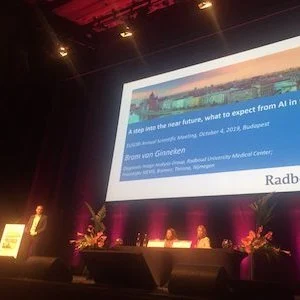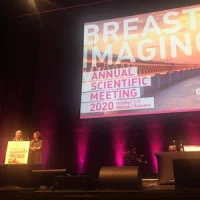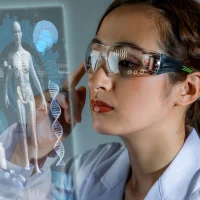How radiologists can use AI in workflow was the theme of the Key Note lecture at EUSOBI 2019 ‘A step into the near future. What to expect from AI in radiology’.
Bram van Ginneken, Professor of Medical Image Analysis at Radboud University Medical Center spoke about how AI could impact productively on workflow.Providing an overview of AI, Machine Learning and Deep Learning, he touched on misperceptions of the technology within the Imaging community.
“Many people are afraid of deep learning,” he told delegates at congress venue, the Budapest Congress Centre. “They think deep learning is a black box. But the human mind is much more of black box.”
Van Ginneken outlined scenarios where AI could contribute to saving time and money in Imaging by working alongside radiologists. Suggestions included:
- Working in the background to flag abnormalities.
- Double-checking radiologists recommendations for referral in order to reduce unnecessary work.
- Scoring every Imaging examination and in, Europe, not sending every exam to radiologists for double reading if AI thinks it’s not needed.
- Performing a second reading in the standard double reading procedure to reduce radiologist workload.
- Saving reading time with large examinations such with as Tomosynthesis, 3D and MRI material.
The AI pioneer did, however, note the risks and roadblocks associated with AI.
“Who would be better arbiter – computer or radiologists?” he asked. “And what if AI misses important findings. Who takes the blame for AI errors?”
He also stressed that AI should not make disastrous errors as this would not be accepted by society.
“Roadblocks are more a legal matter on whether society wants us to use algorithms rather than a technical matter.”
Van Ginneken suggested an AI Imaging adoption roadmap over the next five years with a gentle introduction into low-risk tasks that wouldn’t slow the radiology workflow.
“If AI is running in background and radiologists
see it’s working and taking over the boring aspects of work, it will be easier
to adopt.”
This year’s meeting is
organised in collaboration with the Hungarian Society of Radiology,
Section of Breast Imaging, with active participation of Hungarian pathologists,
breast surgeons, medical oncologists and radiation oncologists.
Source: HealthManagement.org Live Coverage
Image Credit: HealthManagement.org Live Coverage










